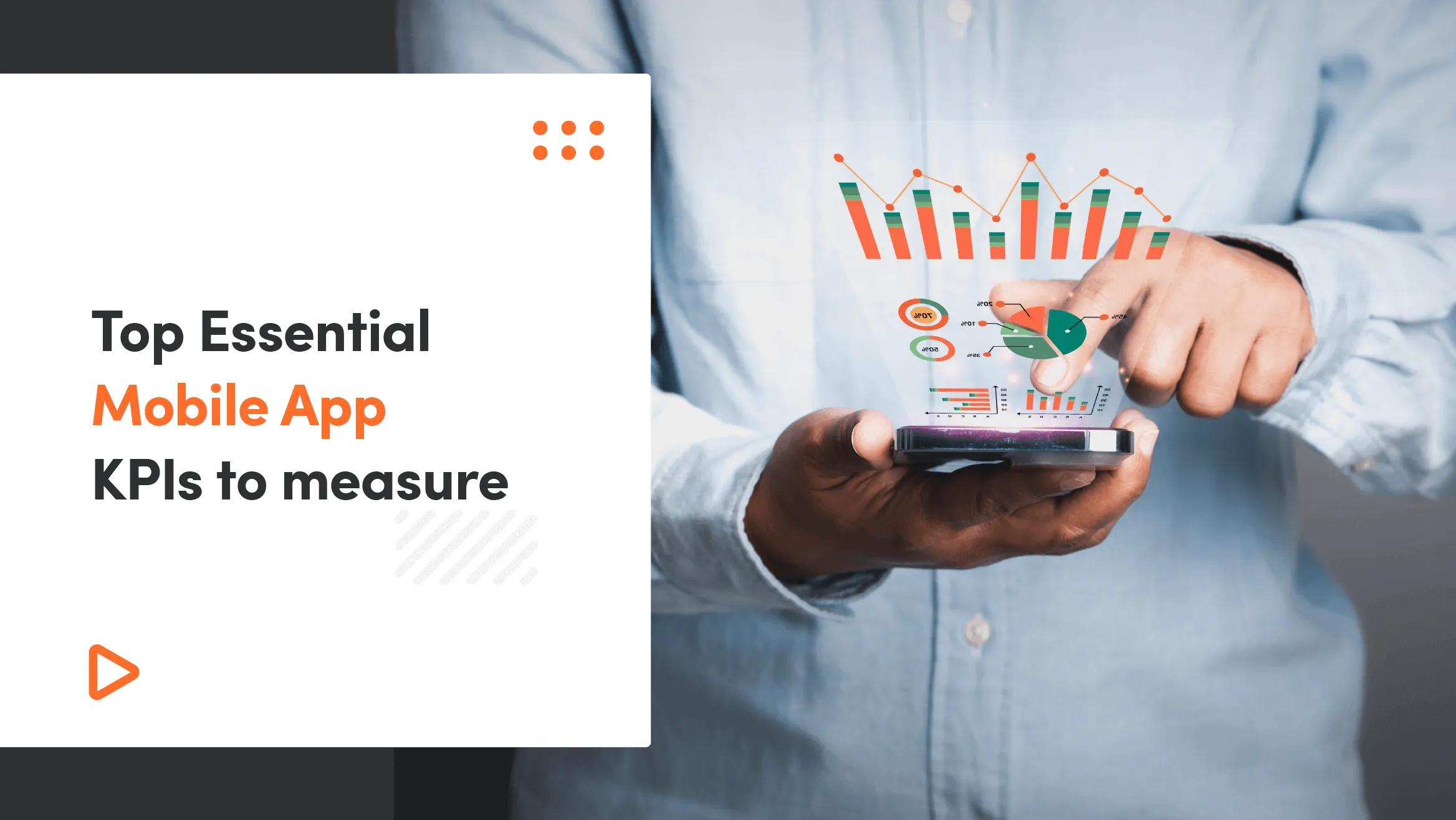Data forms the foundation of customer involvement. While consumer data receives the majority of attention—as seen by the debate over first- versus third-party data—it's crucial for marketers to understand other types of data, such as metrics, benchmarks, and key performance indicators (KPIs). With this data, it is possible to determine which customer engagement efforts and programs are effective and which need to be redesigned. However, while there are several perspectives from which to look at engagement and performance, not all are created equally.
Quantifying engagement is crucial for marketers that want to evaluate the effectiveness of their interactions with app users. What's working and what isn't, and how can you tell? The following list of 10 critical metrics formulae and mobile app KPIs will assist you in assessing the impact of the effort you have invested in growing your audience.
KPIs vs. Metrics: What's the Difference
Metrics and KPIs are frequently used interchangeably. But in reality, things don't function in this manner. Even though they are both quantitative metrics, they have different uses. Simply said, measurements only evaluate the effectiveness of certain business activities or processes, whereas KPIs alone evaluate how well targets or goals are being fulfilled. Let's take a closer look at a few of the distinctions.
All KPIs are some kind of Metrics
Though all KPIs are some form of measure, not all metric types function as KPIs. A good KPI is usually closely related to a result; you anticipate it to rise or fall to accomplish its goal. You only need to make sure you are using the correct metrics to measure it. A KPI will need a set of metrics to track its performance. Though all KPIs are metrics, not all metrics are KPIs, so keep that in mind.
KPIs measure the performance
KPIs track how well parts of your company operations perform, provide a more comprehensive, strategic view of your objectives, and frequently include several measurements.
KPIs offer a broad perspective, and they stand for important business objectives for various departments. On the other hand, metrics are thought of as lower-level indicators, and they monitor activities or procedures exclusive to a division or business sector.
Metrics Measure Specific Parameters
Metrics need to be viewed within a larger context since they measure certain aspects of your item or service (e.g., paired or compared with other metrics).
As seen from the sales example, only some metrics can be used to measure the effectiveness of your strategic efforts. On the other hand, metrics assess the influence of the daily performance of various business areas. The key lesson from this is that metrics and KPIs are not incompatible, which is why they are frequently regarded as synonymous terms.
Why do you need to measure mobile app performance? Why is it important?
The same rules of the market apply to your mobile app as they do to other software goods and services. You must evaluate its key performance indicators to ensure that your company is moving on the correct path. By doing so, you will be able to encourage or expand the desirable occurrences while stopping or diminishing the negative ones.
It takes a lot of moving components, variables, and interactions to create a successful mobile app, both in terms of business and technology. The only approach to keep the complexity in check is to decide which elements are most important for attaining your objectives and then concentrate on enhancing this purposefully condensed set of criteria.
Today, gathering data is often not a major difficulty, but it is essential to concentrate on the KPIs and indicators that are essential to your app's performance. Because of this, the idea of OMTM (One Metric That Matters) was first formally established in the book "Lean Analytics" by Alistair Croll and Benjamin Yoskovitz. It later gained popularity, especially within the startup community. To steer your app toward one, often consistent "North Star Metric" (NSM) of your organization, OMTM is frequently chosen for a particular length of time. The general concept underlying both OMTM and NSM is to lessen the noise from several sources of information, identify which one is essential, and then focus most of the work on enhancing this metric.
Types of KPI Metrics
Depending on where your business is in its growth, a large variety of KPIs and indicators are available to you. Suppose you're testing your app concept, developing an MVP, gaining your first users, turning those users into customers, or sustaining an established app with a sizable user base. In that case, various areas will be more crucial to you.

User Experience
The user experience, from the first step through the visitor's last moment on your app, is the user journey. Everything falls under the user experience category, including layout, design and navigation. Metrics aid in making decisions on providing app users with a wonderful experience. Without Technical performance measurements, this phase cannot be completed.
Technical Performance
You may get information about your app's technical performance through mobile app performance metrics. With the help of these data, you and your app development team can enhance the technical aspects of your app.
These measurements can help you find in-app performance problems that might go unnoticed. This includes sluggish loading, glitches, or issues with the design of your application.
The following are among the UX and mobile app performance metrics:
- Load speed
- Devices and operating systems
- Screen resolution
- Crash reports
User Engagement
You will need to specify exactly what an "active user" for your app entails because not all apps are designed to be used often. Is it opening the app, signing in, or carrying out a crucial action?
The quality of your user experience is more crucial than the efficacy of your engagement initiatives, which can be understood with these app analytics.

Revenue
We're all here for the money, after all. The profit from your app, either through in-app payments or purchases made directly through the app, is referred to as revenue (yes, these are two different things).
These measures also consider the sums paid to recruit new customers and users.
As many of these measures demonstrate the immediate results of your marketing efforts, they may be considered mobile app marketing KPIs.
Among revenue metrics, you'll find:
- Purchases
- Time to first purchase
- User lifetime value
- Conversion rate
- Cost per install
The average revenue per user (ARPU)
How much do people spend on your app? This measure gives you the answer to that query and advice on increasing sales. Additionally, it provides you with information on your audience's financial stability.
User behavior varies among operating systems, as you can see. Android users frequently spend more time in applications and make fewer transactions, whereas iOS users typically produce bigger average checks. That being said, it depends on the specific app and user base, so measure it to find out how does it look in your case.
User Acquisition
Where are your users coming from? This is important if you run advertisements or pay money to attract new users. Metrics for app downloads indicate how frequently users download your app. The amount of daily downloads is one of the numerous app use metrics you ought to monitor because it offers you more clarity on the effectiveness of your marketing initiatives.
Furthermore, being completely aware of the source of your users' traffic enables you to allocate your marketing budget more effectively and accelerate the growth of your user base.
Business Growth
In terms of mobile marketing KPIs, this is sort of the holy grail. A crucial element in formulating future strategy is understanding how much value a campaign generates compared to the amount of money spent on it. Due to the haziness of the relevant factors, it might be challenging to determine. Consider the income produced by conversions through a certain campaign as an example. However, other elements could be at play that had nothing to do with the campaign itself and impacted the money created by conversions.
As long as there is internal agreement on what is being evaluated as a return (profit, net revenue, etc.) and what the investment expenses of the campaign were, it is still viable to compute return on investment (ROI).
Top Mobile App Metrics to Track for Growing Your App
The time it takes for your app to load and become ready for user interaction is referred to as the app load speed. The waiting process irritates mobile users. Even if people patiently wait for an app to download, they won't hesitate to give up on or remove a sluggish application. The retention of mobile app users depends on load speeds for this reason.
According to Think with Google, the amount of time it takes for your app to launch may hurt or help your business. A one-second delay can have a significant effect on your revenue.
Quantifying engagement is crucial for marketers that want to evaluate the effectiveness of their interactions with app users. What's working and what isn't, and how can you tell? The following list of 10 critical metrics formulae and mobile app KPIs will assist you in assessing the impact of the effort you have invested in growing your audience.

Retention Rate
Since users cannot interact with your app if they are no longer using it, retention may be the most crucial KPI for mobile marketers. To stop churn and keep more of your audience coming back, you must first recognize when and if it is happening.
Simply put, retention = revenue. The longer you keep users, the more valuable they are to your business.
There are various methods to quantify retention, but for our purposes, we'll focus on range retention, which measures the number of users who have been retained by comparing their numbers from one week, month, or other date range to those from a subsequent date range of equal size. Therefore, range retention can be calculated by simply dividing the total number of users over a current period (let's say the last month) by the total number of users over a previous period (say, the month before that).
Here's the problem: the average user only installs 10% of the applications on their smartphone each day while keeping between 60 and 90 installed.
How can you get your app into that 10% of applications vying for your users' time and attention when there are so many others?
By monitoring indicators for user retention, we can pinpoint the precise elements in the user experience when individuals are leaving.
Churn Rate
A measure of how many users eventually delete or quit using an app. Both app abandonment rate and app churn are equivalent terms. After users download the app for the first time, this metric is typically calculated at 30, 7, and 1 day. The app churn rate is the ratio of users leaving an app. The difference between app churn rate and app retention rate is how committed a user base is over time and at what point in the app lifecycle consumers abandon it.
Stickiness
The degree to which users interact with an app regularly determines how stickier it is. The more engaged users there are, the more addictive the program becomes.
When talking about daily and monthly active users, the stickiness ratio should be mentioned. You should try to increase the number of times a user login into your app.
You may find the stickiness ratio by dividing the number of daily active users by the number of monthly active users.
Session Duration and Interval
The duration of a user's session in your app and the intervals between them might reveal a lot about their behavior, expectations, and problems arising during your app's interactions.
A mobile app KPI called "session length" measures how long customers spend using your app during a single session. App session intervals track how frequently users come back to your app.
These two things are essential indications of involvement. These raise your retention rate to a new level, which is why I appreciate measuring them. Long session lengths and few session intervals indicate frequent re-opening and prolonged usage of your app.
Research shows that mobile users spend 77% of their time on their favorite three apps.
In-App Purchases
The main justification and requirement for the existence of most commercial applications is their monetization ability. The quantity, price, and nature of in-app transactions are directly related to your business strategy.
It should be rather clear what an in-app purchase is. It's a measure that reveals how frequently people spend actual money on your app.
It goes without saying that to measure a metric like this, purchases and app monetization must be enabled. But it's crucial to monitor this figure over time to determine if specific occasions or marketing initiatives increase the volume of transactions.
For instance, in-app transactions for e-commerce applications could rise during the holiday season. Or perhaps you have a gaming app that increased sales when a certain marketing campaign went live.
Load Time
Your app's performance as a whole may be seen from that one measure. Both show the app's core logic is processed and how it looks to impact it. That figure should be as low as feasible.
Load time is the length it takes for an app to load from the first tap until it is usable. It also depends on the time it takes for a user to switch between screens inside an application.
The user experience improves as a function of how quickly the program loads. Almost often, you want to have the quickest load times.

User Lifetime Value
It's a rate that informs you of the value an average user is projected to provide throughout their "lifetime" (from installing until dropping off and uninstalling the app). All of the in-app purchase money is included in that.
App downloads
You should focus on that as one of the important KPIs. Using this, you can check how the market responds to your app. It summarises and highlights various criteria, including technical performance, user experience quality, and marketing and advertising effectiveness. The actual figure should be interpreted in light of your other measures from a wider perspective.
App Store Rating and Reviews
Your app's rating and reviews impact how satisfied people are. Your app could either benefit or jeopardize your company's ability to grow in the future, depending on how people view it.
Net Promoter Score
The Net Promoter Score (NPS) is a common metric for gauging user happiness with your app. It is often based on a brief poll that asks users if they would suggest it to a friend. Why is this so crucial? According to research, those who a friend has recommended an app are four times more likely to download it. The lifetime value of referred customers is 16% higher than that of regular consumers.
Summary
Your goals will always determine the crucial mobile app metrics you must monitor. The more objectives a team attempts to accomplish, the larger challenge it becomes. The app team should monitor the following crucial mobile metrics, though:
- User growth rate
- Retention rate
- Conversion rate
- Churn rate
- Daily Active Users (DAUs)
- Monthly Active Users (MAUs)
- Session length, interval & depth
- Average screens per visit
as a set of basic information providing an overview of your app’s condition and development stage.
You can now enhance your performance and expand the applications with greater assurance now that you know which KPIs and metrics can provide you with valuable insights about your business.
If you need an expert team to design and develop your app with proper metrics and KPIs in place, you can contact us at Selleo.




